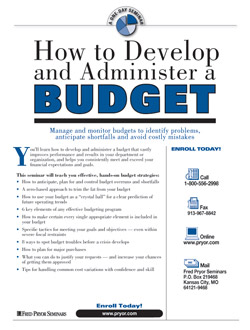An effective budget serves as a road map for your organization's future growth. This course will teach you how to build in contingencies and wisely plan for unforeseen circumstances, making your budget a planning tool with maximum flexibility. You'll see immediate and direct benefits from these practical, hands-on budget principles and strategies.
If you think budgets are a dreaded chore, difficult to comprehend and use or not worth the paper they're written on, this seminar is for you! In one day you'll discover practical skills that dispel these common myths about budgets. You'll learn how to make and administer a budget that vastly improves performance and results in your department or organization … and helps you consistently meet and exceed your financial expectations and goals.
This one-day budgeting seminar covers:
- How to anticipate, plan for and control budget overruns and shortfalls
- A zero-based approach that trims the fat from your budget
- How to use your budget as a "crystal ball" for a clear prediction of future operating trends
- The six key elements of any effective budgeting program
- How to make certain every single appropriate element is included in your budget
- Specific tactics for meeting your goals and objectives — even within severe fiscal restraints
- Eight ways to spot budget troubles early, before a crisis develops
- How to plan for major purchases
- What you can do to justify your requests — and increase your chances of getting them approved
- Tips for handling common cost variations with confidence and skill
- And much more!
This budgeting course is specifically designed for anyone with responsibilities to monitor costs, plan efficient use of resources and achieve objectives and goals. You will learn how to make a budget and capture the information you need to make intelligent operating decisions with confidence!
